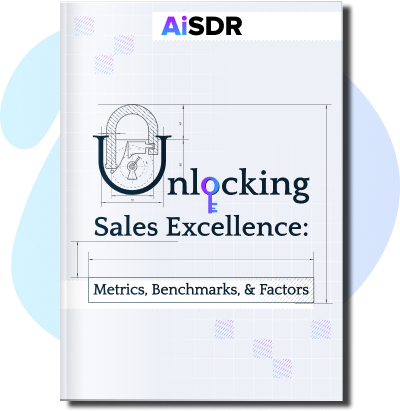Email Framework #4: Show Me You Know Me

Learn about the Show Me You Know Me email framework and how to use it
How well do you know your leads? Or better yet, can your leads tell you’ve done your homework from the way you talk to them in your emails?
That’s what the Show Me You Know Me framework solves. It makes your sales emails more personal, and they give you a better chance of grabbing a lead’s attention.
But while Show Me You Know Me has clear benefits, this framework requires extra effort and time to research. To speed up this process, you can use outreach tools like AiSDR.
Here’s a closer look at the Show Me You Know Me approach and how you can use it to open the door for a better connection.
What is the Show Me You Know Me framework?
Show Me You Know Me (SMYKM) is a framework for writing personalized emails that show you understand the person you’re contacting. But instead of sending a generic message, you add specific details about the recipient, such as their role, pain, or a recent company event.
This helps them feel seen and makes it clear your email isn’t another mass send. And by presenting your solution as a way to solve their unique needs, you’re more likely to get a positive response.
Benefits of the Show Me You Know Me framework
Here are some of the benefits of the SMYKM approach.
Forge a positive relationship built around trust
By showing you’ve done your research into the lead and their situation, your outreach feels more personal and thoughtful. It makes you sound less like you’re pushing a product and more like you’re genuinely trying to help. This builds rapport and increases the chances that leads will engage with you.
Show relevance and value right away
Since your emails address the lead’s unique situation, you make your solution feel custom-fit. Leads become more likely to respond, and your outreach should yield real, meaningful results. The right social proof can further underscore your point.
Differentiate yourself from competing emails
Cold sales emails tend to be broad and impersonal, with only the barest of surface-level personalization. Good SMYKM emails will set you apart from other sales reps who haven’t put in the extra effort to tailor their messaging.
After all, as the name implies, your emails show that you get your leads, while generic messages and templates won’t.
Best practices for SMYKM emails
Here are some best practices for creating effective Show Me You Know Me emails:
- Do deep research – Go beyond scratching the surface when looking into a lead. Don’t settle for top-level personalization details.
- Stay short and relevant – The danger of SMYKM emails is the temptation to add everything you’ve learned. This is a mistake. Long emails will turn off leads to your message, so keep them short and focus only on what’s most important.
- Offer a solution – You’ll want to approach the conversation and show how your product solves their problems. Try to avoid falling into the trap of recapping how epic your features are.
- Use social proof carefully and intentionally – Social proof should be targeted. While it’s cool to show off how you’ve helped companies, it won’t be as effective if the companies aren’t in the same industry. For example, how you helped IT companies won’t prove as convincing to banks.
How to use Show Me You Know Me in sales outreach
Here’s a step-by-step walkthrough of how to apply the Show Me You Know Me framework to emails.
Research your prospect
The entire purpose of SMYKM emails is to show you understand your leads. In other words, do your research thoroughly.
Some areas to look at include:
- Company website
- LinkedIn and other social media
- Industry news, including journals and market newsletters
As you scan through these sources, look for any trends, challenges, or opportunities you can tie into your email. You can use any info you find that’s not job-related in the P.S. section.
Personalize the subject line
Subject lines are the first thing your leads see when deciding whether to give your emails more attention. That’s why you’ll want to use one of the insights you found to create a subject line that can spark their interest and get them to click.
Kick off with a personalized opening
The first sentence of your email is prime real estate, and you’ll want to start with a bang. Or else your leads will stop reading.
That’s why you want to skip niceties like “I hope this email finds you well.”
BUT you also don’t want to dive into your sales pitch.
Instead, use the most interesting or compelling piece of information you found during your research. For max effect, the fact you use should tie to their work or company.
Connect the dots by transitioning from insight to your solution
Here’s the challenge.
The best sales emails don’t break 50 words or 5 sentences. And by this point, you’ve probably used half of this.
So in the next 1 or 2 sentences, you’ll need to weave a story that achieves 3 things: (a) segues from your research to why you’re reaching out; (b) shines the spotlight on a need or pain; (c) describes how your product solves their need or pain.
You know you’ve picked a good pain if you can answer the question “I have this problem. So what?”
And you know you’ve picked a really good pain if you can also highlight the cost of inaction. That’s because loss aversion is a hugely powerful tactic in sales, and sometimes people are twice as responsive to what they lose than what they gain.
Add a call to action
Now that the hard part is over, it’s time to bring the email to a close and let them know the next step.
Don’t use the classic “Book a demo here” though. Use a softer pitch like “Open to a quick call?” or “Can I see you a quick guide?”
And don’t send a calendar link. Recently, first-touch emails that include a link are more likely to be flagged by spam rules.
Show Me You Know Me example
Here’s a closer look at a possible SMYKM email.
General framework
This is the general structure of an SMYKM email.
Hi [name],
[Research]
[Value connection]
[Call to action]
Example email
This is a possible SMYKM email that follows the general structure.
Hi [name],
I saw your post on the challenges of founder-led sales. I agreed with all 3 points, but I was wondering – have you decided your strategy for scaling? Other teams like Metal used AiSDR to 1.8x their revenue by automating emails to inbound leads and getting response times under 10 minutes.
Is this something you’d like to explore?











